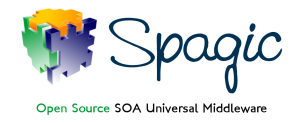Related Research Articles

A workflow is a generic term for orchestrated and repeatable patterns of activity, enabled by the systematic organization of resources into processes that transform materials, provide services, or process information. It can be depicted as a sequence of operations, the work of a person or group, the work of an organization of staff, or one or more simple or complex mechanisms.
The Web Services Business Process Execution Language (WS-BPEL), commonly known as BPEL, is an OASIS standard executable language for specifying actions within business processes with web services. Processes in BPEL export and import information by using web service interfaces exclusively.
In the field of artificial intelligence, an inference engine is a software component of an intelligent system that applies logical rules to the knowledge base to deduce new information. The first inference engines were components of expert systems. The typical expert system consisted of a knowledge base and an inference engine. The knowledge base stored facts about the world. The inference engine applied logical rules to the knowledge base and deduced new knowledge. This process would iterate as each new fact in the knowledge base could trigger additional rules in the inference engine. Inference engines work primarily in one of two modes either special rule or facts: forward chaining and backward chaining. Forward chaining starts with the known facts and asserts new facts. Backward chaining starts with goals, and works backward to determine what facts must be asserted so that the goals can be achieved.

Business process modeling (BPM), mainly used in business process management; software development, or systems engineering, is the action of capturing and representing processes of an enterprise, so that the current business processes may be analyzed, applied securely and consistently, improved, and automated. BPM is typically orchestrated by business analysts, leveraging their expertise in modeling practices. Subject matter experts, equipped with specialized knowledge of the processes being modeled, often collaborate within these teams. Alternatively, process models can be directly derived from digital traces within IT systems, such as event logs, utilizing process mining tools.
Business process automation (BPA), also known as business automation, similar but separate from business process management (BPM), is the technology-enabled automation of business processes.
A BRMS or business rule management system is a software system used to define, deploy, execute, monitor and maintain the variety and complexity of decision logic that is used by operational systems within an organization or enterprise. This logic, also referred to as business rules, includes policies, requirements, and conditional statements that are used to determine the tactical actions that take place in applications and systems.
A workflow pattern is a specialized form of design pattern as defined in the area of software engineering or business process engineering. Workflow patterns refer specifically to recurrent problems and proven solutions related to the development of workflow applications in particular, and more broadly, process-oriented applications.
Data cleansing or data cleaning is the process of detecting and correcting corrupt or inaccurate records from a record set, table, or database and refers to identifying incomplete, incorrect, inaccurate or irrelevant parts of the data and then replacing, modifying, or deleting the dirty or coarse data. Data cleansing may be performed interactively with data wrangling tools, or as batch processing through scripting or a data quality firewall.
Business Process Modeling Language (BPML) is an XML-based language for business process modeling. It was maintained by the Business Process Management Initiative (BPMI) until June 2005 when BPMI and Object Management Group announced the merger of their respective business process management activities to form the Business Modeling and Integration Domain Task Force. It is deprecated since 2008. BPML was useful to OMG in order to enrich UML with process notation.
A workflow engine is a software application that manages business processes. It is a key component in workflow technology and typically makes use of a database server.
Drools is a business rule management system (BRMS) with a forward and backward chaining inference-based rules engine, more correctly known as a production rule system, using an enhanced implementation of the Rete algorithm.

Apache ODE is a software coded in Java as a workflow engine to manage business processes which have been expressed in the Web Services Business Process Execution Language (WS-BPEL) via a website. It was made by the Apache Software Foundation and released in a stable format on March 23, 2018. The software principally communicates with one or more Web services, sending and receiving messages, manipulating data and handling exceptions (errors) as defined by any given process. The engine is capable of running both long and short living processes to coordinate all the services that make up a service or application (orchestration).

Spagic is a Universal Middleware, characterized by an innovative approach to the governance and realization of SOA solutions, which are highly modular and configurable around an OSGi kernel.
Event-driven SOA is a form of service-oriented architecture (SOA), combining the intelligence and proactiveness of event-driven architecture with the organizational capabilities found in service offerings. Before event-driven SOA, the typical SOA platform orchestrated services centrally, through pre-defined business processes, assuming that what should have already been triggered is defined in a business process. This older approach does not account for events that occur across, or outside of, specific business processes. Thus complex events, in which a pattern of activities—both non-scheduled and scheduled—should trigger a set of services is not accounted for in traditional SOA 1.0 architecture.
Business process management (BPM) is the discipline in which people use various methods to discover, model, analyze, measure, improve, optimize, and automate business processes. Any combination of methods used to manage a company's business processes is BPM. Processes can be structured and repeatable or unstructured and variable. Though not required, enabling technologies are often used with BPM.
In philosophy, a process ontology refers to a universal model of the structure of the world as an ordered wholeness. Such ontologies are fundamental ontologies, in contrast to the so-called applied ontologies. Fundamental ontologies do not claim to be accessible to any empirical proof in itself but to be a structural design pattern, out of which empirical phenomena can be explained and put together consistently. Throughout Western history, the dominating fundamental ontology is the so-called substance theory. However, fundamental process ontologies have become more important in recent times, because the progress in the discovery of the foundations of physics has spurred the development of a basic concept able to integrate such boundary notions as "energy," "object", and those of the physical dimensions of space and time.

TACTIC is a web-based, open source workflow platform and digital asset management system supported by Southpaw Technology in Toronto, ON. Designed to optimize busy production environments with high volumes of content traffic, TACTIC applies business or workflow logic to combined database and file system management. Using elements of digital asset management, production asset management and workflow management, TACTIC tracks the creation and development of digital assets through production pipelines. TACTIC is available under both commercial and open-source licenses, and also as a hosted cloud service through Amazon Web Services Marketplace.
In information technology a reasoning system is a software system that generates conclusions from available knowledge using logical techniques such as deduction and induction. Reasoning systems play an important role in the implementation of artificial intelligence and knowledge-based systems.
Imixs Workflow is an Open-Source-Project, providing technologies for building Business Process Management solutions. The project focus on human based workflows used to execute and control workflows in organisations and enterprises. In difference to task-oriented workflow engines, which focus on automated program flow control (tasks), Imixs Workflow is a representative of an event-based workflow engine. Here, the engine controls the status of a process instance within a defined state-diagram. By entering an event, the state of a process instance can be abandoned or changed. In human-centric workflow engines, events usually occur by an interaction of the actor with the system, for example by approving or rejecting a business transaction. They can also be triggered by scheduled events. An example of this is an escalation of an unfinished task.
Executable choreography represents a decentralized form of service composition, involving the cooperation of several individual entities. It is an improved form of service choreography. Executable choreographies can be intuitively seen as arbitrary complex workflows that get executed in systems belonging to multiple organisations or authorities.
References
- ↑ "Do you know where all of your company's business rules are?". Computerworld. 39 (21). IDG Enterprise (published 2005-05-23): 25. 23 May 2005. ISSN 0010-4841 . Retrieved 2014-02-02.
Rules engines have been around since the early 1990s when companies such as Pegasystems Inc. in Cambridge, Mass., Fair Isaac Corp. in Minneapolis and ILOG in Mountain View, Calif., sold them. They were typically used in rules-heavy industries such as finance and insurance. Over the past few years, however, many vendors have entered the market, and more companies are looking at rules engines as a way to gain greater flexibility in business operations.
- ↑ "eMerge Rule-based software development platform".
- ↑ Is Your Rules Engine Event-Driven? Retrieved from http://www.sapiens-tech.com/iDuneDownload.dll?GetFile?AppId=225&FileID=216581&Anchor=&ext=.pdf Archived 2018-09-30 at the Wayback Machine .
- ↑ "The DARL language". Archived from the original on 2018-09-01. Retrieved 2018-09-01.